The Omelette
Wednesday, February 3rd, 2010Years ago, I took a cooking class that focused on eggs. Out of all the classes I have taken, I would argue that this one was the best, the most revelatory. I still think back to that day-long Saturday class in which I developed a fundamental understanding of the most versatile and elemental tool in cooking: the magnificent egg! The chef started the class by cooking scrambled eggs, and then launched into eggs benedict, a prospect that made my mouth water until she said she would be making it with bearnaise sauce instead of hollandaise. I’m sure my face visibly sagged with disappointment. I had wanted the classic experience, the purest form of eggs benedict. I wanted to witness precisely what it should be and, for me, that involved hollandaise. But had I gotten my wish, I never would have tasted bearnaise and I would never have become The Best Eggs Benedict Maker I Know. The bearnaise deserves all the credit. The perfectly poached free-range eggs, the precisely chewy English muffins, the hand-shaved black-forest ham, all of these things play a part, but it is the bearnaise that lifts the eggs benedict to its most glorious form. We don’t even order eggs benedict at restaurants anymore. What’s the point? How could it ever measure up to mine? (And with that kind of hubris, I will never again be able to poach an egg.)
More recently, I read Michael Ruhlman’s The Elements of Cooking: Translating the Chef’s Craft for Every Kitchen, or at least the non-encyclopedic part of the book, and my appreciation for the egg increased even further. He writes, “My reverence of the egg borders on religious devotion.” From that loaded introduction, he proceeds to list the reasons why the egg is the epitome of food perfection (page 22, if anyone cares to read it) and elaborates on its various methods of preparation. If ever I needed a reason to love the egg even more, this gave me a trove of pro arguments. One of things he discusses, of course, it the making of an omelette. In my Introduction to Eggs class, the chef told us all that the making of an omelette is something that many chefs use to test the skill of their potential staff, something I’ve heard echoed a few times since then. So naturally, I felt that the first skill I was going to work to perfect was the making of an omelette.
It turns out that the method which I was taught was sort of a cross between an American-style country omelette, and a classic French omelette. (Dude, I hadn’t even known there were different types of omelettes, let alone techniques.) I was taught to use a very hot, non-stick skillet, to slowly draw the large curds from the outer edges of the pan towards the center, to fold the finished omelette into three overlapping parts, and, under no circumstances, should I ever allow the bottom of the omelette to brown. This technique, I thought, was The Way To Make An Omelette. Little did I know of the variations in technique, and the incredible difference in flavour the technique can make. I mean, eggs is eggs! How different could they taste if scrambled or made into an omelettle?! Turns out: quite a bit, my friend.
Since that fateful class, I have been drawn to any and all kinds of instruction on how to make an omelette. We’ve watched the America’s Test Kitchen version, which involved using chopsticks and the broiler; I must’ve read a couple dozen of written How To’s; we’ve watched Julia Child make them, Julia & Jacques make them, Bobby Flay make them and – the latest – Jacques sans Julia make them. Truly, they are astonishingly different, these lessons. I have to say, I liked Jacques Pepin’s classic version the best even though I CAN’T STAND that he uses a metal fork to scrape the bottom of a non-stick skillet.
I think it’s fair to say that I am still developing my own style. I like the idea of using chopsticks to help swirl and scramble the eggs around the pan because it’s easy to use them as pincers to pick up the edges if need be, and I am determined to master the technique of folding it into a perfect Pepin-torpedo. I respect the knowledge of the egg that Rulman imparted and if ever the omelette turns into scrambled eggs, I adopt Julia’s attitude of “no excuses and no apologies”. Above all, I love the creamy taste of the classic French omelette, and that alone warrants the effort. It is that version that I plan to perfect, and when I do, I think I’ll buy a chef’s hat.
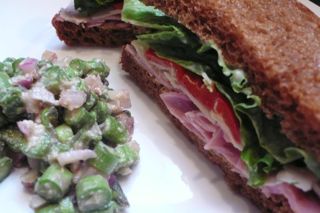 Since we’ve begun baking our own bread, it is only natural that our sandwiches have begun to involve a little more thought and effort. Marc produced a glorious loaf of
Since we’ve begun baking our own bread, it is only natural that our sandwiches have begun to involve a little more thought and effort. Marc produced a glorious loaf of 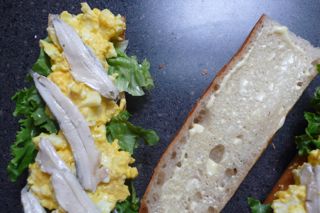
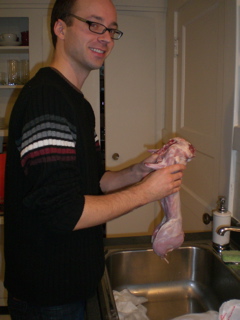
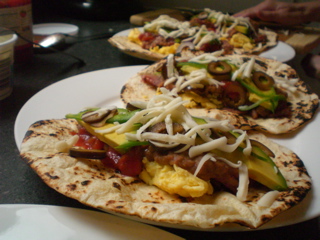 Inspired by the breakfast burrito at Nellie’s Restaurant in Calgary and the fennel sausage pizza from
Inspired by the breakfast burrito at Nellie’s Restaurant in Calgary and the fennel sausage pizza from 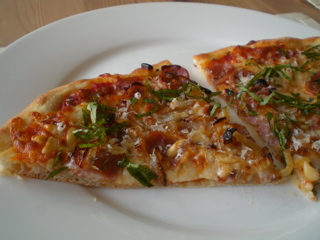
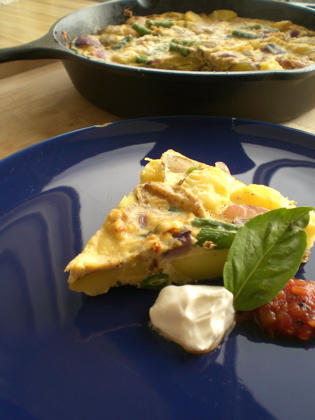 I was left to figure something out for supper after having forgotten to go to the grocery store. I failed to find a use for the jar of kimchi or the fennel, but managed to put everything else together into a fine frittata. Thyme, Chili powder and salsa were added to the beatten eggs. The potatoes were well boiled, having learned a lesson for the last time I tried to make a frittata.
I was left to figure something out for supper after having forgotten to go to the grocery store. I failed to find a use for the jar of kimchi or the fennel, but managed to put everything else together into a fine frittata. Thyme, Chili powder and salsa were added to the beatten eggs. The potatoes were well boiled, having learned a lesson for the last time I tried to make a frittata.